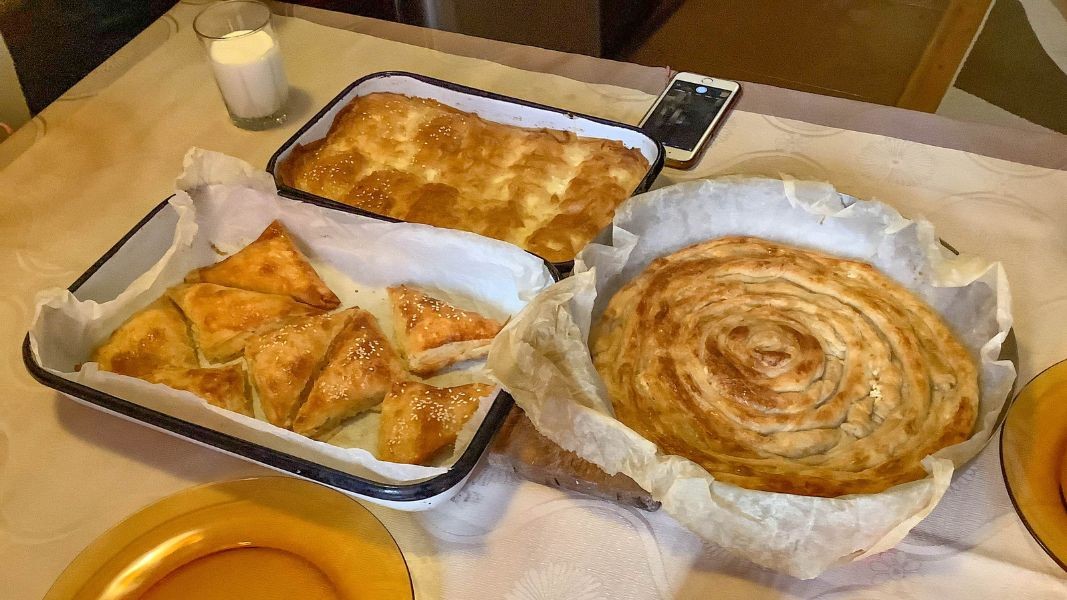A Japanese woman traveled 13,000 kilometers to visit Plovdiv and learn how to make ... banitsa (Bulgarian cheese pie). Makiko Miura is a producer of Bulgarian lyutenitsa (red pepper and tomato chutney) in the Japanese prefecture of Yamagata, where the made-in-Japan delicacy arouses mass curiosity and increasingly appears on the table of her compatriots.

Makiko claims to have drawn inspiration from Bulgarian rhythmic gymnast Antoaneta Vitale. During the coronavirus pandemic our compatriot lived in Japan, where she promoted Bulgarian sports and cuisine in the local media. Makiko contacted her and received valuable tips on how to prepare authentic Bulgarian lyutenitsa. 3 years later, Makiko visited her in Plovdiv, in order to learn how to make banitsa. She admits that she fell in love with the Bulgarian pastry dish at first sight, without even tasting it.
"It happened while I was watching a TV show. Japan’s national public broadcaster NHK presented your lyutenitsa and banitsa. I had never tried banitsa before, but I was very intrigued, as happened with your lyutenitsa some time ago. Therefore, I wanted to come here and try some banitsa and learn how to make it myself. I would like to introduce your banitsa to the Japanese people, but I don't know whether I will find Bulgarian cheese and filo pastry on our market. Not to mention that even the Japanese flour is different! I'll have to tailor it to the Japanese taste, like I did with your pepper and tomato chutney", Makiko concludes.

The first thing she did when she arrived in Plovdiv was to go to a supermarket. She was impressed by the wide variety of pepper and tomato chutneys on the stands. Next, she bought a banitsa from a street shop. She said that it was salty and sharp at the first bite, because of the cheese. Later, she rolled up her sleeves and tried to make the Bulgarian delicacy in Antoaneta Vitale’s home.

''I welcomed her and we had a wonderful four-day cultural exchange, because she came home and cooked us sushi one day. Otherwise, we made banitsa - says Antoaneta. - I wanted to show her how to make homemade banitsa with ready-made filo pastry and separately – banitsa with homemade pastry using a rolling pin, which is not so easy. I thought Makiko wouldn't be able to find ready-made filo pastry in Japan and she'd better make it herself. We made banitsa topped with with egg, yoghurt and sparkling water, but we also made a type of banitsa that is sold in bakeries. The idea was to teach Makiko how to prepare different types of banitsa in Japan, where there is a great interest in all things Bulgarian. The Japanese are not only attracted by our yoghurt, which is considered a very healthy product, but also by our rhythmic gymnastics, roses and wine", Antoaneta Vitale said in an interview for Radio Bulgaria.

Musaka (yoghurt-topped dish made with ground meat, onions, potatoes, tomatoes and seasoning) and tarator (a refreshing cold soup made with yoghurt, cucumbers, garlic and dill) are among the local dishes that strongly impressed Makiko. She was also impressed with our fruit, especially watermelons. ''Watermelons in Japan are small, but here they are so big and tasty!'', Makiko exclaims. She admits that she bought rose water and rose petals from Plovdiv to make tea at home, while considering ways to popularize the Bulgarian banitsa in the Land of the Rising Sun.
See also:
Bulgarian banitsa shines in a world ranking - what we don't know about this traditional dish
Autumn comes in Bulgaria with the smell of roastеd peppers and attention to lyutenitsa
Five popular Bulgarian dishes that may seem a bit strange to some
Bulgaria's State Automobile Inspectorate (DAI) is the official body that deals with the control of heavy-duty traffic on the territory of the country, as part of the Executive Agency "Automobile Administration" (IAAA). Its work became the subject of..
With a concert by the Slavey Quartet created by folk singer Nadka Karadzhova and a conversation about the problems of our compatriots in the Western Outlands, the Cultural and Information Center of the Bulgarian Minority in..
Athens is under pressure to sell fighter jets that would be delivered to Ukraine Greece is reluctant to provide high-tech military equipment that could be used against Russia, reports BNR’s correspondent in Greece Katya Peeva...
The Bulgarian National Radio hosted the annual Public Broadcasters International (PBI) Conference for the first time. Heads and representatives of public..
Long-distance sailing captain Svetlozar Tenev has set off from the port city of Varna on Bulgaria's northern Black Sea coast on a circumnavigation of the..
A meeting titled “Mission Water” is taking place today at Burgas State University “Prof. Dr Assen Zlatarov”. The event gathers researchers involved..

+359 2 9336 661
